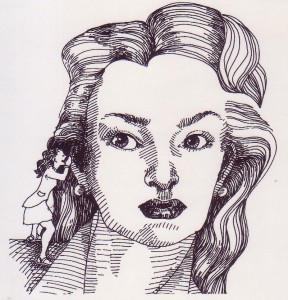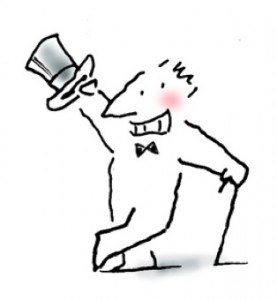It Is Natural
 I’ve been getting ready for my upcoming retreat with Ajahn Sucitto by listening to some of the dharma talks he gave at his last retreat. The talk I listened to last night was especially wonderful. The title is The Natural Stream to Liberation and he starts by reading this selection from the Numerical Discourses. (The talk is an hour long, but it would almost be enough just to listen to him read this sutta, which is on the first 7 minutes of the tape. To listen, click here.)
I’ve been getting ready for my upcoming retreat with Ajahn Sucitto by listening to some of the dharma talks he gave at his last retreat. The talk I listened to last night was especially wonderful. The title is The Natural Stream to Liberation and he starts by reading this selection from the Numerical Discourses. (The talk is an hour long, but it would almost be enough just to listen to him read this sutta, which is on the first 7 minutes of the tape. To listen, click here.)
For a virtuous person, one whose behavior is virtuous,
no volition need be exerted:
“Let non-regret arise in me.”
It is natural that non-regret
arises in a virtuous person, one whose behavior is virtuous.
For one without regret,
no volition need be exerted:
“Let joy arise in me.”
It is natural that joy arises in one without regret.
For one who is joyful,
no volition need be exerted:
“Let rapture arise in me.”
It is natural that rapture arises in one who is joyful.
For one with a rapturous mind,
no volition need be exerted:
“Let my body be tranquil.”
It is natural that the body of one with a rapturous mind is tranquil.
For one tranquil in body,
no volition need be exerted:
“Let me feel pleasure.”
It is natural that one tranquil in body feels pleasure.
For one feeling pleasure,
no volition need be exerted:
“Let my mind be concentrated.”
It is natural that the mind of one feeling pleasure is concentrated.
For one who is concentrated
no volition need be exerted:
“Let me know and see things as they really are.”
It is natural that one who is concentrated knows and see things as they really are.
For one who knows and sees things as they really are,
no volition need be exerted:
“Let me be disenchanted and dispassionate.”
It is natural that one who knows and sees things as they really are is disenchanted and dispassionate.
For one who is disenchanted and dispassionate,
no volition need be exerted:
“Let me realize the knowledge and vision of liberation.”
It is natural that one who is disenchanted and dispassionate realized the knowledge and vision of liberation.
Thus Bhikkhus, the knowledge and vision of liberation is the purpose and benefit of disenchantment and dispassion.
Disenchantment and dispassion are the purpose and benefit of the knowledge and vision of things as they really are.
The knowledge and vision of things as they really are is the purpose and benefit of concentration.
Concentration is the purpose and benefit of pleasure.
Pleasure is the purpose and benefit of tranquility.
Tranquility is the purpose and benefit of rapture.
Rapture is the purpose and benefit of joy.
Joy is the purpose and benefit of non-regret.
And non-regret is the purpose and benefit of virtuous behavior.
Thus, Bhikkhus, one stage flows into the next stage,
one stage fills up the next stage,
for going from the near shore
to the far shore.
(Anguttara Nykaya, The Book of the Nines.)
#59: Don’t Expect a Standing Ovation
(Joseph Goldstein’s variation on one of the Tonglen Mind Training slogans.)
Unwise Attention
 In some ways, we didn’t “get very far” in our discussion last night of Joseph Goldstein’s new book, Mindfulness: A Practical Guide to Awakening, because we started…and ended…on page 17, where the Buddha is quoted as saying, “whatever we frequently think of and ponder, that will become the inclination of our minds.”
In some ways, we didn’t “get very far” in our discussion last night of Joseph Goldstein’s new book, Mindfulness: A Practical Guide to Awakening, because we started…and ended…on page 17, where the Buddha is quoted as saying, “whatever we frequently think of and ponder, that will become the inclination of our minds.”
But though we didn’t get “far” in terms of pages, I think we went a long way in terms of practice, because we spent most of the time talking about what all this means about what we should do….in our daily life, with relationships, work situations, conflicts and struggles. Especially when there are people and things that really piss us off!
The discussion brought to mind something I had just read in Bhikkhu Analayo’s excellent (but formidably titled): Excursions into the Thought-World of the Pali Discourses.
Here’s what Analayo says, quoting directly from the Buddha’s teachings:
A prominent cause of the arising of ill-will is unwise attention to the sign of irritation (AN I 3). [By “sign of irritation” he means whatever it is that we get pissed off about.] Once ill-will has arisen, the mind tends to return again and again to the particular sign, event or person that has occasioned the arising of ill-will.
As to what to do about it:
Intentional relaxation can have substantial results if applied directly to the mind itself. The point here is that ill-will inevitably involves a narrow perspective, usually a focusing on the irritating and displeasing aspect of a situation or a person at the exclusion of other aspects that do not reinforce irritation….A conscious broadening of the scope of perception can go a long way in undermining the foundations of ill-will.
So in plain English:
Don’t spend so much energy thinking about whatever it is that’s pissing us off. Recognize it, yes, but then expand the focus of attention to include things about the person or situation that do NOT piss us off!
***
(illustration by George Willett, from Roger von Oech’s Creative Whack Pack)
Spend the Day with Jack
 Jack Kornfield will be leading a daylong meditation retreat at Spirit Rock on Sunday, April 6….but you don’t have to fly to California to attend! (And even if you did, you wouldn’t be able to get in, because now it’s SOLD OUT.)
Jack Kornfield will be leading a daylong meditation retreat at Spirit Rock on Sunday, April 6….but you don’t have to fly to California to attend! (And even if you did, you wouldn’t be able to get in, because now it’s SOLD OUT.)
The whole day will be offered as a LIVE video stream, 11:00 am to 7:00 pm (St. Louis time), which you can attend by registering here.
And if you’re busy on the day of the event…..no problem! If you register before the daylong begins, you will have access to the recorded event for 90 days. Cost is $30.
This is a traditional Insight Meditation (vipassana) daylong retreat that will include systematic instructions, silent sitting and walking meditation, and a dharma talk, suitable for both beginning and experienced meditators. It’s a great opportunity to sit and walk and listen to Jack.
Don’t miss it!
A Peek at a Retreat
 Last year, artist Maira Kalman sat her first ever silent retreat at IMS (Insight Meditation Society, in Barre, MA) and produced a series of illustrations about her experience, which appeared over several months in Mindful Magazine.
Last year, artist Maira Kalman sat her first ever silent retreat at IMS (Insight Meditation Society, in Barre, MA) and produced a series of illustrations about her experience, which appeared over several months in Mindful Magazine.
Here’s the first installment. (Click on the image to enlarge.)
Wake Up!
 I was in kind of a fog today and just couldn’t think of what I wanted to post. So I stood in front of my bookshelf for a while until I found myself picking up one of the books, then I just sort of let it fall open….to see if something might present itself.
I was in kind of a fog today and just couldn’t think of what I wanted to post. So I stood in front of my bookshelf for a while until I found myself picking up one of the books, then I just sort of let it fall open….to see if something might present itself.
The book turned out to be Comfortable with Uncertainty: 108 Teachings, by Pema Chodron
Here’s the page it opened up to:
#20: “All activities should be done with one intention.”
Breathing in, breathing out, feeling resentful, feeling happy, being able to drop it, not being able to drop it, eating our food, brushing our teeth, walking, sitting–whatever we’re doing could be done with one intention. That intention is that we want to wake up, we want to ripen our compassion, we want to ripen our ability to let go, we want to realize our connection with all beings. Everything in our lives has the potential to wake us up or to put us to sleep. Allowing it to awaken us is up to us.
***
I post this today with the intention to wake up!
May it be so.
What It’s Like
Mindful magazine asked artist Lisa Congdon to meditate for 15 minutes and to illustrate her experience. Here’s what it was like for her. Sound familiar?
(Click on the image to see it full size. Or check out the April issue of Mindful magazine. It’s on the back page.)
Mindful Morning
 Want to get off to a good start? Try this practice from Emotional Chaos to Clarity, by Phillip Moffitt:
Want to get off to a good start? Try this practice from Emotional Chaos to Clarity, by Phillip Moffitt:
“The practice of starting your day with clarity begins with becoming mindful of what’s true in your body and your mind when you awaken. So while you’re still lying in bed, notice if you feel rested or if you’re still tired. Is your body tense or at ease? What parts of your body are relaxed?
“Next observe your mind and notice whether it is relaxed or tense, quiet or busy. What is it doing? Is it resting, planning, complaining, rehearsing, or remembering a dream? Is it fuzzy or clear? Is it experiencing an emotion such as excitement, dread, or fear? You now know what needs your attention.
“The next step is to use your body or your mind state as an object of contemplation…Maybe you don’t feel rested, or you feel rested but parts of your body are tense, or when you think about your day parts of your body tense up…
“In response to whatever you discover to be true in your body, continue to lie in bed and do a body scan. In a body scan you progressively tense and relax each part of your body as you imagine healing energy moving through it…
“Once you’ve completed your body scan, which can take as little as five minutes or as much as half an hour, turn your attention to what’s going on in your mind…. Is there underlying tension? Is it racing? Jumpy? If so, invite the mind to relax. You can evoke this feeling of relaxation in a number of ways: focus on a soothing memory or image, reflect on something you”re grateful for, or do loving-kindness practice in your mind [send wishes of well-being to those you love]…
“After relaxing your body and mind as best you’re able, the next step in starting your day is to contemplate what lies ahead. First picture the day in your mind. Observe your attitude….When you focus on something that’s difficult or requires a lot of attention, pause, breathe, and allow your body and mind to relax.
“Repeat this process of imagining, noticing, and relaxing until you feel centered. This feeling of centeredness becomes your reference point when you’re actually engaged in the difficult activities you imagined.”
Training the Heart
 The Monday night Dharma Book Group met last night to continue our discussion of Joseph Goldstein’s new book Mindfulness: A Practical Guide to Awakening. We went around the room, reading aloud passages that stood out for us, and then we talked about them.
The Monday night Dharma Book Group met last night to continue our discussion of Joseph Goldstein’s new book Mindfulness: A Practical Guide to Awakening. We went around the room, reading aloud passages that stood out for us, and then we talked about them.
Here’s one of the passages I read out:
Without mindfulness, we simply act out all the various patterns and habits of our conditioning. Ajahn Sumedho, one of the senior Western monks of the Thai Forest tradition, quite aptly pointed out that, contrary to some popular beliefs, our aim should be not to follow the heart but to train the heart.
All of us have a mix of motivations; not everything in our hearts is wise or wholesome. The great power of mindful discernment allows us to abandon what is unwholesome and to cultivate the good. This discernment is of inestimable value for our happiness and wellbeing.
With recurring unskillful thoughts, we need an actively engaged mindfulness, because, as the Buddha pointed out, whatever we frequently think of and ponder, that will be the inclination of our minds. Mindfulness has the power to show us what kinds of thoughts are arising, and in the case of unskillful ones, what we may have unknowingly been inclining our minds toward. The simple reflection that these thoughts actually do lead to one’s own and others’ affliction and difficulty, away from wisdom and awakening, is an effective tool to use in those times rather than being just a phrase to read.
Where to Sit
 It took me a long time to get this: meditation does not require sitting on the floor.
It took me a long time to get this: meditation does not require sitting on the floor.
When I told my first teacher that I had trouble meditating because I kept getting painful “pins and needles” in my legs, she said I should try sitting in a chair. She said that she often sat on her living room couch, because it was comfortable and convenient. I was appalled. I didn’t want to sit in a chair — or a couch! I wanted to sit on the floor, with my legs crossed…like a real meditator!
So I struggled…for years….to sit on the floor. I was almost always in pain. But I thought that if I kept doing it, my legs would finally get used to it, and then the pain would go away, and then I’d be meditating.
I actually did sit in a chair quite a lot of that time…but I always felt like I was “cheating.” And then little by little I noticed that the ease of sitting in a chair allowed me to be more relaxed and open to my experience, and because of that, I was able to be more fully present, less resistant, more attentive…until finally it dawned on me that this was what I was supposed to be doing all along. Not fighting my body. Opening my mind!
So sit in a chair, if you want. Or on the floor. It really doesn’t matter. Just find a place where you can be at ease. Sit in a way that is alert, but relaxed. Don’t slump. If you’re in a chair, it helps to have the bottoms of your feet touching the floor. Drop your shoulders. Let your arms be comfortable and your hands relaxed. Close your eyes, if that feels right. Or keep them open, but with a soft, unfocused gaze. Let yourself settle for a few minutes. Maybe take a couple of deep breaths. Notice how it feels to be where you are.
Smile.
You’re meditating!
***
Don’t know what to do next? Try the Virtual Retreat I posed here.


